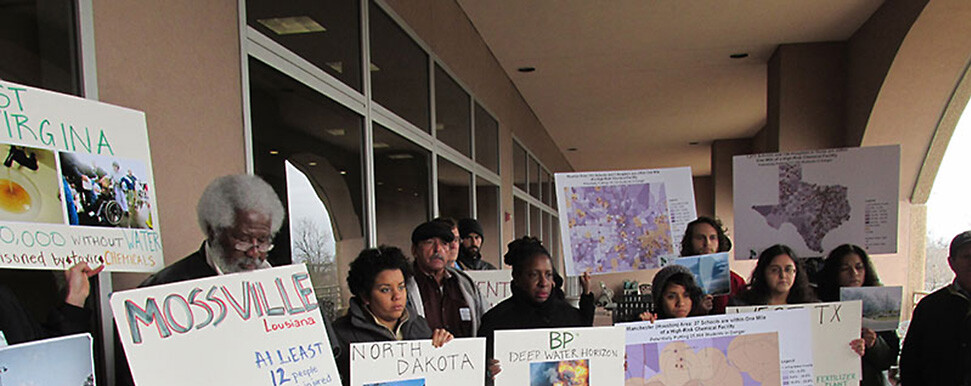
Media
March 13, 2020Release: Court Approves Settlement Requiring EPA Rules on Most Dangerous Chemical Spills
New York, N.Y. – The U.S. District Court for the Southern District of New York approved a consent decree between the U.S. Environmental Protection Agency and a coalition of community and environmental organizations, including the Environmental Justice Health Alliance for Chemical Policy Reform (EJHA), Clean Water Action, and Natural Resources Defense Council (NRDC).
The consent decree requires EPA to issue long-overdue rules requiring robust hazardous substance spill-prevention and response planning for the most dangerous chemical facilities – which, because of their proximity to water, pose a serious threat to human health and the environment. Under the agreement, the agency must issue proposed rules within 2 years, and finalize them 2.5 years after that. This represents a victorious end to the federal lawsuit the organizations filed against EPA in March of 2019 for failing to issue these regulations for nearly thirty years, despite a clear mandate from Congress in the 1990 amendments to the Clean Water Act.
"The sad reality of fenceline and frontline communities is that toxic chemical facilities are permitted to disproportionately burden them with billions of pounds of toxic pollution, while at the same time putting them at risk of devastating incidents like the recent back to back explosions in Houston,” said Michele Roberts, National Co-Coordinator of the Environmental Justice Health Alliance (EJHA). "Fenceline communities know that it’s not if, but when the next chemical leak, spill or flooding event will happen, and the cumulative impacts of these tragic events are unjustly borne by people of color and low-income residents. EPA's mission is to protect our health and the environment. It is way beyond time for EPA to exercise the moral and political courage to protect these overburdened communities from the daily assaults on their health and quality of life."
“The need is greater now than ever for the EPA to issue decisive rules that require industries to protect our communities from the dangers they pose,” said José Bravo, Executive Director of Just Transition Alliance, an affiliate of EJHA. “We have been waiting 30 years for the EPA to act. As we see more and worsening weather events, the need for prevention and protection will continue to grow. The EPA will finally be mandated to protect our communities once and for all.”
"Finally EPA will act to make sure extreme weather events and other worst case scenarios don't result in drinking water contamination and water pollution. This was what Congress intended and is part of the unfinished business of the landmark Clean Water Act," said Lynn Thorp, Clean Water Action’s National Campaigns Director.
“This is a victory for the millions of people who live in fear of experiencing catastrophic chemical spills in their own backyards,” said Kaitlin Morrison, Attorney at the Natural Resources Defense Council (NRDC). “This consent decree holds EPA to the rule of law and protects fenceline communities from preventable toxic chemical exposures.”
EPA’s failure to establish worst-case scenario spill planning regulations for chemical facilities like aboveground storage tanks storing hazardous substances has left a substantial gap in environmental and public health protections from chemical spills. An estimated 2,500 U.S. chemical facilities located in flood-prone areas nationwide are subject only to state-level worst-case spill-planning requirements – which, if they exist at all, are vulnerable to rollback at any time.
Hurricane Harvey highlighted this glaring regulatory gap – despite Houston’s density of chemical facilities and susceptibility to severe flooding, Texas does not require facilities storing hazardous substances to develop specific plans for how to prevent and respond to worst-case scenario spills, including those caused by storms and natural disasters. In the wake of Hurricane Harvey, numerous facilities released harmful chemicals through spills, leaks and explosions, causing some first responders to be hospitalized. Once the worst-case scenario spill plans are in place at those facilities, many of these exposures and injuries could be avoided.
Ensuring that EPA fully complies with its duty to issue spill-prevention and response regulations will reduce the risk of environmental and health harms from preventable chemical spills, and help address the long-standing disproportionate burdens that chemical production and storage impose on fenceline communities, where most residents are low-income or people of color.
Read the full consent decree here.
# # #
This is a joint release between the Environmental Justice Health Alliance for Chemical Policy Reform, Clean Water Action, and the Natural Resources Defense Council.
Media Contact: Maria Michalos, mmichalos@nrdc.org, 646-889-1404
